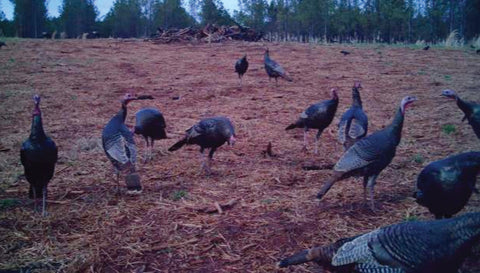Planting Turkey Gold Chufa for Turkeys
During the spring, the NWTF is flooded with calls from members and landowners with questions about what to plant for wild turkeys. One of most popular crops is chufa. Turkeys are attracted to patches of chufa and will utilize them for months.
Chufa is a warm season perennial plant and a member of the nutsedge family, but it is not invasive like other nutsedges and will not create problems for any crops planted after it. Chufa does not do well with competition and if not managed properly it will disappear. Chufa is actually one of the oldest domesticated crops we have. Its cultivation is known to have occurred over 2,000 years ago! Even though chufa produces large clumps and lush, narrow-leaved foliage, it is the underground golden tubers produced by the plant that turkeys relish.
The general rule is that chufa can be planted almost anywhere corn can. It needs about 100 days of growing season to mature and produce nut-like tubers, which are high in carbohydrates and protein. In the South, chufa is normally planted from April through July, depending on soil and rainfall. In the north the best planting time is early May through the first week in June.

Chufa will grow in a variety of soil types, but it does best in moderately to well-drained sandy or loamy soils. It will grow in clay soils, but turkeys have a harder time scratching the tubers out. Plots should be plowed and disked to prepare a good seedbed and soil amendments added as recommended by a soil test.
Chufa can be drilled or broadcast at a rate of 40 to 50 pounds per acre. If the seed is broadcast, cover it at least 2 inches with a harrow, disk or drag. Too deep and the seed will never see the light of day – allow it to sit at the surface and every crow, turkey and raccoon will thank you for the free meal. Typically drill using peanut plates at about 40 pounds per acre. When broadcasting, since all seeds won’t be covered at the perfect depth, increase the rate to around 50 to 55 pounds per acre and make sure to cover at least 2 inches.
Specific herbicides may be necessary to control grass and weed competition. Treflan can be used as a pre-emergent to keep weeds from growing in the first place. A selective contact herbicide such as Poast (plus crop oil surfactant) can be used to kill grasses growing in chufa and 2,4-DB can be used to eliminate any unwanted broadleaf plants.
Brown plants are a sure indicator the tubers are ready and waiting just below the surface. Once turkeys start feeding on the chufa, they will continue using it regularly through the fall, winter and into the spring in areas where the ground is not frozen. If planting chufa in an area for the first time, pull some of the plants out of the ground or disk a strip to familiarize the birds with the new food source.
A chufa patch heavily used by turkeys resembles a bunch of hogs rooting up the ground. Turkeys usually stop visiting the patches when all the tubers are exhausted or spring green-up presents more favorable food.
The NWTF imports a fresh crop of chufa seed from Spain each year, where it is grown for the food industry. NWTF Turkey Gold chufa is high quality, commercially processed and cleaned with high purity and germination. It is available on the BioLogic website or at many retailers throughout the wild turkeys’ range.








